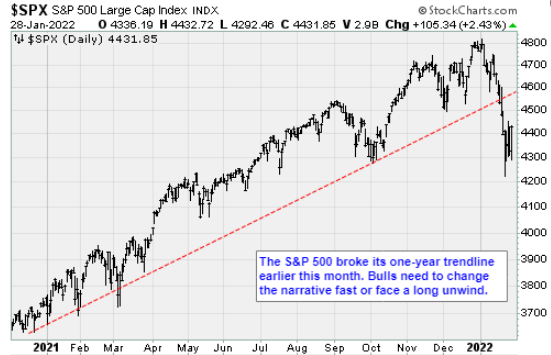The S&P 500 (SPX) started down 0.8% on Friday, then rallied fiercely to finish at 4,432, a gain of 2.4%, states Jon Markman, editor of Strategic Advantage.
The reversal pushed the benchmark S&P 500 (SPX) back above the 200-day moving average at 4,430. If stocks open firm on Monday, I expect bears will concede a rally back to 4,530. That move should happen quickly. Pundits who were bearish a week ago will claim that the correction is over. Not quite.
Corrections are a battle of attrition. Bears are certain to defend the 4,530 level, and the talking points that led to the decline early last week have not been resolved. Inflation is too high. The Federal Reserve is tightening monetary policy.

This is a trading range until either bulls or bears break through defenses emphatically. The bottom is 4,210 for the S&P 500, while the top is 4,600. Bears have better facts and momentum, but bulls can still muster a recovery, especially with new money coming into the market early in the new month.
The stock market had suffered three consecutive days of last hour drops before Friday's late comeback in another highly volatile session. The Nasdaq surged 3.1% to 13,770.57 to end slightly higher for the week and the Dow rose 1.7% to 34,725.47, for a 1.3% weekly gain.
Technology stocks fared best, bolstered by Apple's (AAPL) 7% gain after the iPhone maker late Thursday reported fiscal first-quarter earnings and revenue above consensus estimates. Real estate stocks also did well, with energy the only sector in the red.
Breadth slightly favored advancers six-two, and there were 46 new highs vs 1514 new lows. Big caps on the new high list included CVS Health Corporation (CVS), Petroleo Brasileiro (PBR), Vertex Pharmaceuticals (VRTX), Archer-Daniels-Midland Company (ADM), and McKesson (MCK). Another weird vanguard of cats and dogs.
The 10-year US Treasury yield fell two basis points to 1.79%. West Texas Intermediate crude oil rose 0.6% to $87.14 a barrel. Oil prices rose for a sixth consecutive week to seven-year highs amid concerns over supply disruptions if Russia attacks Ukraine, Commerzbank said in a Friday note.
In economics news, the US personal consumption expenditure price index rose by 0.4%, as expected, lifting the year-over-year increase to 5.8% in December from 5.7% the prior month, the largest annual gain since 1982.
The University of Michigan consumer sentiment index for January was revised lower to 67.2 from the preliminary estimate of 68.8, now further below December's reading of 70.6 and the lowest reading since November 2011. This is unexpected and scary for bulls; economic improvement depends on optimistic consumers.
The employment cost index—a measure of wage inflation—rose 1% in the fourth quarter after a 1.3% increase in the third quarter. Wage costs rose 1.1% after jumping 1.5% in the third quarter, while benefits costs rose 0.9% for the second straight quarter. The year-over-year increase for ECI accelerated to a 20-year high, reflecting a tight labor market.
In company news, Visa (V) reported an increase in earnings and sales in the fiscal first quarter, beating analyst estimates. Shares surged nearly 11% to lead the S&P 500 and the Dow. You know Visa and Mastercard (MA) are two of my favorite ways to play consumerism and e-tail.
Caterpillar (CAT) reported higher-than-expected results for the final quarter of 2021 as customer demand firmed. Still, the heavy equipment maker said it expects first-quarter margins to be under pressure amid elevated costs. Shares fell 5.2%.
Microsoft (MSFT) continued to rise after delivering upbeat fiscal second-quarter results, driven in part by the performance of Azure late Wednesday. The technology giant forecast "strong revenue growth" in the quarter currently underway amid solid customer demand for hybrid and cloud offerings. Shares rose 2.8% Friday.




















